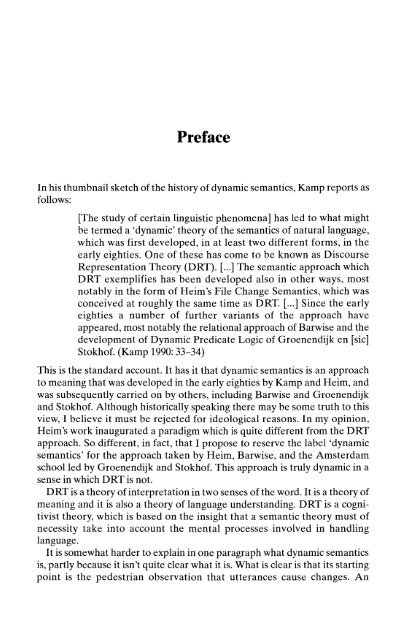- Page 2 and 3: Presuppositions and Pronouns
- Page 4 and 5: PRESUPPOSITIONS AND PRONOUNS Bart G
- Page 6 and 7: Current Research in the Semantics/P
- Page 8 and 9: To Julia
- Page 10 and 11: Contents PREFACE xi 1 PRESUPPOSITIO
- Page 14 and 15: xiii presuppositions already involv
- Page 16 and 17: CHAPTER 1 Presupposition The phenom
- Page 18 and 19: Presupposition 3 c. If Barney has s
- Page 20 and 21: Presupposition 5 apply to their int
- Page 22 and 23: Presupposition 17 sentences in (15)
- Page 24 and 25: Presupposition 9 there is a way of
- Page 26 and 27: Presupposition 11 judgment of the f
- Page 28 and 29: Presupposition 13 that requires a m
- Page 30 and 31: Presupposition 15 b. If Barney took
- Page 32 and 33: Presupposition 17 conditionals have
- Page 34 and 35: Presupposition 19 pizzeria in the V
- Page 36 and 37: Presupposition 21 recipient of this
- Page 38 and 39: Presupposition 23 (45) Fred's wife
- Page 40 and 41: Presupposition 25 (51) [the x: King
- Page 42 and 43: Presupposition 27 readings in terms
- Page 44 and 45: Presupposition 29 actually has a nu
- Page 46 and 47: Presupposition 31 describes a trans
- Page 48 and 49: Presupposition 33 of this complexit
- Page 50 and 51: CHAPTER 2 The binding theory Althou
- Page 52 and 53: The binding theory 37 b. [y,.w: [v,
- Page 54 and 55: The binding theory 39 correlated wi
- Page 56 and 57: The binding theory 41 (10) a. Eithe
- Page 58 and 59: The binding theory 43 The content o
- Page 60 and 61: d. j [.
- Page 62 and 63:
The binding theory 47 apply. Soames
- Page 64 and 65:
The binding theory 49 Disjunction '
- Page 66 and 67:
The binding theory 51 me from sayin
- Page 68 and 69:
The binding theory 53 (35) a. [u, v
- Page 70 and 71:
The binding theory 55 line, presupp
- Page 72 and 73:
The binding theory 57 We are now al
- Page 74 and 75:
The binding theory 59 interpretatio
- Page 76 and 77:
The binding theory 61 accommodation
- Page 78 and 79:
The binding theory 63 sentence (i.e
- Page 80 and 81:
The binding theory 65 In the preced
- Page 82 and 83:
The binding theory 67 presuppositio
- Page 84 and 85:
The binding theory 69 Our procedure
- Page 86 and 87:
The binding theory 71 c. (Esker too
- Page 88 and 89:
The binding theory 73 (67) The doct
- Page 90 and 91:
The binding theory 75 an umbrella,
- Page 92 and 93:
The binding theory 77 and although
- Page 94 and 95:
The binding theory 79 any given pre
- Page 96 and 97:
The binding theory 81 marker x in t
- Page 98 and 99:
The binding theory 83 In the versio
- Page 100 and 101:
The binding theory 85 (88) a. Did y
- Page 102 and 103:
CHAPTER 3 The satisfaction theory C
- Page 104 and 105:
The satisfaction theory 89 Accordin
- Page 106 and 107:
The satisfaction theory 91 b. c[(p
- Page 108 and 109:
The satisfaction theory 93 (7) Eith
- Page 110 and 111:
The satisfaction theory 95 conditio
- Page 112 and 113:
The satisfaction theory 97 § 3.4 a
- Page 114 and 115:
The satisfaction theory 99 merely p
- Page 116 and 117:
The satisfaction theory 101 All I h
- Page 118 and 119:
The satisfaction theory 103 I belie
- Page 120 and 121:
The satisfaction theory 105 Karttun
- Page 122 and 123:
The satisfaction theory 107 implies
- Page 124 and 125:
The satisfaction theory 109 enterta
- Page 126 and 127:
The satisfaction theory 111 manner.
- Page 128 and 129:
The satisfaction theory 113 trigger
- Page 130 and 131:
CHAPTER 4 Dynamic semantics The dif
- Page 132 and 133:
Dynamic semantics 117 the existenti
- Page 134 and 135:
Dynamic semantics 119 taken serious
- Page 136 and 137:
Dynamic semantics 121 phenomena suc
- Page 138 and 139:
Dynamic semantics 123 implementatio
- Page 140 and 141:
Dynamic semantics 125 number of pos
- Page 142 and 143:
Dynamic semantics 127 having to ass
- Page 144 and 145:
Dynamic semantics 129 Here anaphora
- Page 146 and 147:
Dynamic semantics 131 (19) a. Eithe
- Page 148 and 149:
CHAPTERS 5 Attitude reports Althoug
- Page 150 and 151:
Attitude reports 135 believe, but n
- Page 152 and 153:
Attitude reports 137 Presupposition
- Page 154 and 155:
Attitude reports 139 (11) Hob think
- Page 156 and 157:
Attitude reports 141 have chosen to
- Page 158 and 159:
Attitude reports 143 For the verb w
- Page 160 and 161:
Attitude reports 145 he has a son,
- Page 162 and 163:
Attitude reports 147 all obvious th
- Page 164 and 165:
Attitude reports 149 common sense n
- Page 166 and 167:
Attitude reports 151 (34) a. There
- Page 168 and 169:
Attitude reports 153 (39) a. [x, y,
- Page 170 and 171:
Attitude reports 155 c. c - [
- Page 172 and 173:
Attitude reports 157 (46b) involves
- Page 174 and 175:
Attitude reports 159 5.5 Presupposi
- Page 176 and 177:
Attitude reports 161 I have said th
- Page 178 and 179:
Attitude reports 163 The first pres
- Page 180 and 181:
Attitude reports 165 This argument
- Page 182 and 183:
Attitude reports 167 It may sometim
- Page 184 and 185:
Attitude reports 169 there is a boy
- Page 186 and 187:
Attitude reports 171 and asserts of
- Page 188 and 189:
Attitude reports 173 (74) c. [p,p',
- Page 190 and 191:
CHAPTER 6 Modals As it stands, the
- Page 192 and 193:
Modals 177 111 can be dealt with by
- Page 194 and 195:
Modals 179 means that the material
- Page 196 and 197:
Modals 181 (13) a. Either it is in
- Page 198 and 199:
Modals 183 It is difficult to link
- Page 200 and 201:
Modals 185 Assuming just that modal
- Page 202 and 203:
Modals 187 g(q') S(q') = {(v,j) { E
- Page 204 and 205:
Modals 189 b. Nobody turned up at B
- Page 206 and 207:
Modals 191 q. Thus our theory impli
- Page 208 and 209:
Modals 193 The discourse in (39) is
- Page 210 and 211:
Modals 195 On the Kratzer/Lewis ana
- Page 212 and 213:
Modals 197 bound and is therefore a
- Page 214 and 215:
Modals 199 that the first sentence
- Page 216 and 217:
CHAPTER 7 Names What could be simpl
- Page 218 and 219:
Names 203 had scope but will also t
- Page 220 and 221:
Names 205 why use this word when a
- Page 222 and 223:
Names 207 Although it is always har
- Page 224 and 225:
Names 209 apparent difficulties, ca
- Page 226 and 227:
Names 211 have names; some of these
- Page 228 and 229:
Names 213 is (14c). Hence, on the p
- Page 230 and 231:
Names 215 that he himself might hav
- Page 232 and 233:
Names 217 alternative theories of m
- Page 234 and 235:
Names 219 Since John treats anaphor
- Page 236 and 237:
Names 221 NPs, and in doing so he b
- Page 238 and 239:
References Asher, N. 1986: Belief i
- Page 240 and 241:
References 225 Grice, H.P. 1975: Lo
- Page 242 and 243:
References 227 Levinson, S.c. S.C.
- Page 244 and 245:
References 229 Zeevat, H. 1989a: A
- Page 246 and 247:
Subject index accessibility: 38-39,
- Page 248 and 249:
Index of names Asher, N. xiii, 37,1














